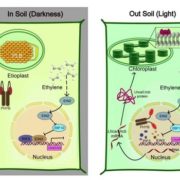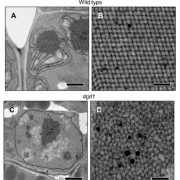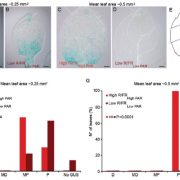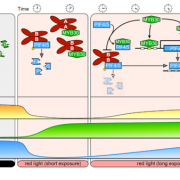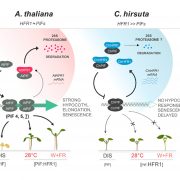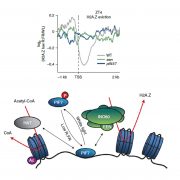Shade avoidance responses in Chinese white poplar rely on shared and unique roles of phytochrome-interacting factors
 Shade avoidance syndrome (SAS) is a set of adaptive growth responses to low red to far-red light ratios. SAS includes petiole and internode lengthening and upward bending of leaves (hyponasty). In Arabidopsis, PHYTOCHROME B (PHYB) and PHYTOCHROME INTERACTING FACTORS (PIFs) are implicated in these responses. Little is known, however, about the mechanism behind SAS in trees. Here, Sun et al. investigated how Populus tomentosa (Chinese white poplar) responds to simulated shade. Overexpression of PtoPHYB1/2 leads to attenuated SAS responses in shade-grown plants when compared to the wild-type, supporting previous reports that these photoreceptors play a conserved role in this species. Binding assays indicated that, as in Arabidopsis, PtoPIFs bind PtoPHYB1/2. Testing mutant and overexpressing lines of eight PtoPIF sequences revealed that while PtoPIF1/3.1/3.2 overexpression leads to taller and more shade-sensitive plants, those overexpressing PtoPIF8.1/8.2 are shorter than WT, yet hyponastic. It was also observed that, as in Arabidopsis, PtoPIFs induce the expression of the auxin biosynthesis gene PtoYUCCA8. These results show that while the main PHYB-PIF regulation module is conserved in P. tomentosa, PtoPIFs display both shared and unique functions in regulating SAS. (Summary by Johnatan Vilasboa @vilasjohn) Plant Cell Environ. 10.1111/pce.14853
Shade avoidance syndrome (SAS) is a set of adaptive growth responses to low red to far-red light ratios. SAS includes petiole and internode lengthening and upward bending of leaves (hyponasty). In Arabidopsis, PHYTOCHROME B (PHYB) and PHYTOCHROME INTERACTING FACTORS (PIFs) are implicated in these responses. Little is known, however, about the mechanism behind SAS in trees. Here, Sun et al. investigated how Populus tomentosa (Chinese white poplar) responds to simulated shade. Overexpression of PtoPHYB1/2 leads to attenuated SAS responses in shade-grown plants when compared to the wild-type, supporting previous reports that these photoreceptors play a conserved role in this species. Binding assays indicated that, as in Arabidopsis, PtoPIFs bind PtoPHYB1/2. Testing mutant and overexpressing lines of eight PtoPIF sequences revealed that while PtoPIF1/3.1/3.2 overexpression leads to taller and more shade-sensitive plants, those overexpressing PtoPIF8.1/8.2 are shorter than WT, yet hyponastic. It was also observed that, as in Arabidopsis, PtoPIFs induce the expression of the auxin biosynthesis gene PtoYUCCA8. These results show that while the main PHYB-PIF regulation module is conserved in P. tomentosa, PtoPIFs display both shared and unique functions in regulating SAS. (Summary by Johnatan Vilasboa @vilasjohn) Plant Cell Environ. 10.1111/pce.14853


